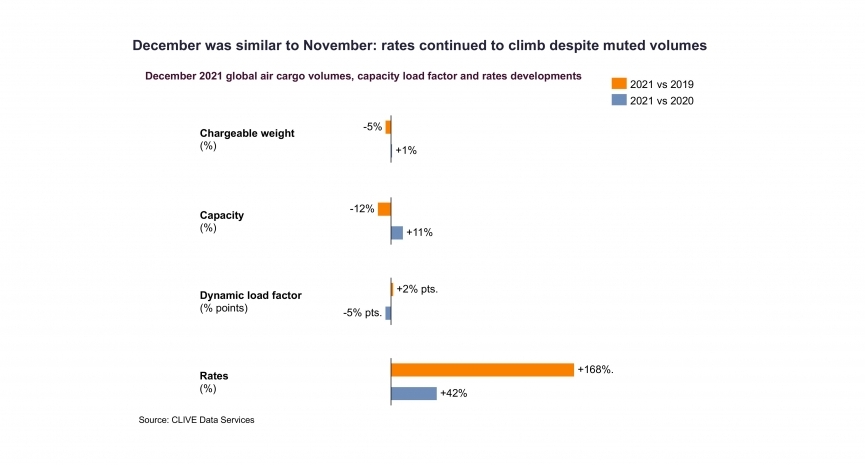December air cargo demand dampened by supply chain issues, omicron concerns
December demand in the general air cargo market put a final dampener on 2021 peak season volumes as continuing supply chain issues, congestion on the ground, and concerns over the new Omicron virus suppressed any end-of-year uptick, according to industry analysts, CLIVE Data Services.

January 5, 2022: December demand in the general air cargo market put a final dampener on 2021 peak season volumes as continuing supply chain issues, congestion on the ground, and concerns over the new Omicron virus suppressed any end-of-year uptick, according to industry analysts, CLIVE Data Services.
CLIVE’s latest weekly market intelligence shows a -5 percent fall in chargeable weight in December 2021, compared to the pre-Covid level of December 2019, making it, versus 2019, one of the weaker months of the year. Versus December 2020, volumes rose by +1 percent. CLIVE’s analyses of the general air cargo market for the last calendar month continued to measure performance to both the pre-covid 2019 level, as well as giving 2020 year-over-year comparisons, to provide a meaningful assessment of its current performance.
Q4 2021 data has reflected CLIVE’s statement earlier in the year that issues facing the air cargo market were driven by supply chain challenges, and less so by soaring volumes. In October, CLIVE’s ‘dynamic loadfactor’ – which measures both the volume and weight perspectives of cargo flown and capacity available to produce a true indicator of airline performance – reported a lower load factor for the time of year than expected, followed in November by a -1.2 percent drop in volumes.
Cargo capacity has remained slow to return to the pre-Covid level. In December 2021, it remained at -12 percent to December 2019. The ‘dynamic loadfactor’ for this December of 65 percent was +2 percent pts up versus two years ago.
The big growth curve in Q4 of 2021 was in airfreight rates, which in December climbed at a global level to 168 percent ahead of December 2019 (+42 percent versus December 2020), following earlier monthly gains compared to 2019 of 155 percent and 159 percent in October and November 2021 respectively.
“It was certainly more complex to ship goods from A to B in 2021 by all modes of transport, which has continued to increase rates. In the general air cargo market, we’ve seen airlines focus more on managing margins than on filling aircraft,” said Niall van de Wouw, CLIVE’s managing director.
“From a volume perspective, compared to 2019, November and December did not produce ‘the peak of all peaks’. The capacity and ‘dynamic loadfactor’ trends were more or less in line with earlier months, but rates kept on climbing. So, what is at play here? This latest December data amplifies what we saw in November, with issues on the ground impacting the efficiency of the value chain. The rapid increase on Omicron and its impact on staff availability, hard lockdowns and their impact on business and consumer confidence are likely at play here.”
He added: “Looking at 2021 overall, after a very strong start to the year and pretty solid middle months, we witnessed a not-so-strong ending of the year. The wear and tear of close to 20 months of Covid started to really impact the efficiency of the value chain towards the end of 2021, and there are still no fundamental changes expected in the short-term that would change the current dynamics of supply chain shortages and elevated rates.”
Source: stattimes.com


